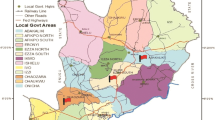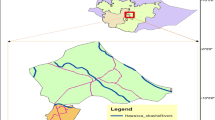Abstract
Slate quarrying in Mahendragarh district of Haryana state has resulted in changes in soil properties. Most of the mining area is devoid of vegetation. The soil in and around the mining area (0–1 km) is alkaline (pH 11.2–11.7) but non-saline (electrical conductivity < 4). The alkaline nature of the soil was attributed to the high concentrations of hydroxyl (OH−), carbonate (CO 2−3 ) and bicarbonate (HCO3 −) present in minerals of mined materials. Biotite, limonite, kaolinite, gibbsite, muscovite, geothite, dolomite and so on were the chief minerals added to soil through mining. The physical properties of soil, i.e. porosity, water-holding capacity (WHC), bulk density and particle density represented poor soil health in mining area (34.4, 29.8%, 1.636, 2.496 g/cc, respectively) and they improved with distance away from it (46.4, 38.3%, 1.070, 2.180 g/cc, respectively, at a distance of 1 km). Porosity and WHC were found to be a function of increased organic matter away from the mining area. CO 2−3 , HCO −3 , phosphate (PO 3−4 ), lead (Pb) and iron (Fe) were more in mining area and decreased with distance. On the other hand, sodium (Na+), potassium (K+), chloride (Cl−), sulphate (SO 2−4 ), organic carbon, total Kjeldahl’s nitrogen, cation exchange capacity, chromium (Cr) and cadmium (Cd) increased with distance from mining area. High concentration of heavy metals in mining area was a cause of concern (0.93 μg/g Cd, 22.35 μg/g Cr, 26.25 μg/g Pb, 1,383.75 μg/g Fe). The change in physico-chemical properties could be because of the addition of chemical constituents that are a part of major minerals present in mined material. The soil away from mining area represented comparatively better properties.


Similar content being viewed by others
References
ASTM D854 (2001) Standard test method for specific gravity by water pycnometer. Annual book of ASTM standards: 04.08. American Society for Testing and Materials, West Conshohocken
Babut M, Sekyi R, Rambaud A, Potin-Gautier M, Tellier S, Bannerman W, Beinhoff C (2003) Improving the environmental management of small-scale gold mining in Ghana: a case study of Dumasi. J Cleaner Prod 11(2):215–221
Bruijnzeel LA (2004) Hydrological functions of tropical forests: not seeing the soil for the trees? Agric Ecosyst Environ 104(1):185–228
Bzowski Z, Dawidowski A (2002) Evaluating the impact of mine groundwater on the environment. Int J Surf Min Reclam Environ 16(2):97–104
Cappuyns V, Swennen R, Vandamme A, Niclaes M (2006) Environmental impact of the former Pb–Zn mining and smelting in East Belgium. J Geochem Explor 88:6–9
Eaton AD, Clesceri LS, Greenberg AE (1995) Standard methods for the examination of water and wastewater, 19th edn. APHA, Washington
Gee GW, Bauder JW (1979) Particle size analysis by hydrometer: a simplified method for routine textural analysis and a sensitivity test of measured parameters. Soil Sci Soc Am J 43:1004–1007
Ghose MK (2003) Indian small-scale mining with special emphasis on environmental management. J Cleaner Prod 11(2):159–165
Harthill M, Mckell CM (1979) Ecological stability: is this a realistic goal for arid land rehabilitation? In: Wali MK (ed) Ecology and coal resource development, vol. 2. Pergamon, Elmsford, New York, pp 557–567
Jackson ML, Tyler SA, Wills AL, Bourbeau GA, Pennington RP (1948) Weathering sequence of clay-size minerals in soils and sediments. Fundamental generalizations. J Phys Colloidal Chem 52:1237–1260
Jha AK, Singh JS (1991) Spoil characteristic and vegetation development on an age series of mine spoils in a dry tropical environment. Vegetation 97:63–76
Kumar R (1996) Impact of silica sand mining activity on environment in Faridabad district, Haryana. In: Symposium on earth sciences in environmental assessment and management, Bangalore, India, 17 May 1996, Abstracts, 91 pp
Loredo J, Pereira A, Ordonez A (2003) Untreated abandoned mercury mining works in a scenic area of Asturias (Spain). Environ Int 29(4):481–491
National Institute for Occupational Safety and Health (NIOSH) (1994) NIOSH manual of analytical methods, 4th edn. Publication No. 94–113. DHHS (NIOSH), Cincinnati
Organiscak JA, Reed WMR (2004) Characteristics of fugitive dust generated from unpaved mine Haulage roads. Int J Surf Min 18(4):236–252
Pandey DD, Kumar S (1996) Impact of cement dust pollution on biomass, chlorophyll, nutrients and grain characteristics of wheat. Environ Ecol 14(4):872–875
Riba I, DelValls TA, Forja JM, Gomez-Parra A (2002) Monitoring the impact of the Aznalcollar mining spill on recent sediments from the Guadalquivir estuary, southwest Spain. Bull Environ Contam Toxicol 69:129–138
Singh B, Katiyar VS, Dwivedi VK (1991) Characteristics of limestone mined lands. A review. Indian J Soil Conserv 19:79–82
Standards Association of Australia (SAA) (1977) AS 1289E 3.3. Determination of the field dry density of a soil: core cutter method for fine-grained soils. http://www.dlwc.nsw.gov.au/care/soil/soil_pubs/soil_tests/pdfs/bd.pdf
Thussu JL (1993) Quaternary geology and geomorphological mapping in parts of Haryana. Rec Geol Surv India 126(8):5–10
Acknowledgment
The authors are thankful to Dr Sushmita Baskar, Department of Environmental Science and Engineering and Dr Devender Kumar, Department of Applied Chemistry, Guru Jambheshwar University of Science and Technology, Hisar for their help in mineral analysis.
Author information
Authors and Affiliations
Corresponding author
Rights and permissions
About this article
Cite this article
Haritash, A.K., Baskar, R., Sharma, N. et al. Impact of slate quarrying on soil properties in semi-arid Mahendragarh in India. Environ Geol 51, 1439–1445 (2007). https://doi.org/10.1007/s00254-006-0440-9
Received:
Accepted:
Published:
Issue Date:
DOI: https://doi.org/10.1007/s00254-006-0440-9




